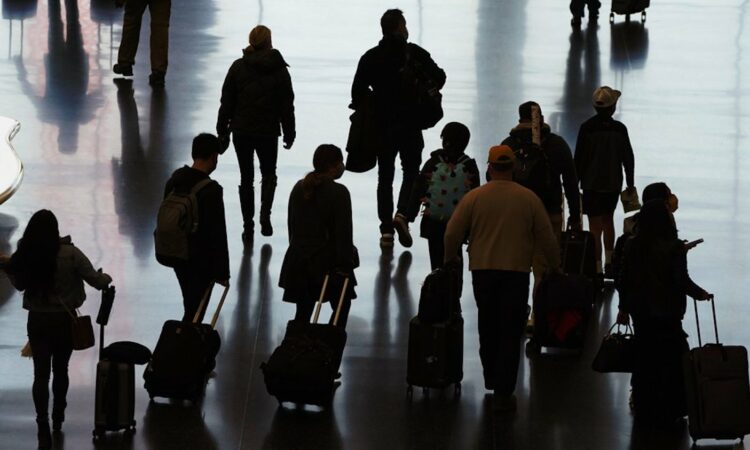© Photo by Rick Bowmer/AP
Americans Broke Pandemic Travel Records Over the Holidays—Despite Warnings
Photo by Rick Bowmer/AP Holiday travelers at Salt Lake City International Airport in Utah.
The appeals from public health officials began prior to Thanksgiving, when the CDC first asked the American public to stay home for the holiday as the country experienced a mounting surge in coronavirus cases. They continued into December, when Dr. Anthony Fauci, the nation’s top infectious disease expert, said the United States could expect to see a “surge upon a surge” as we entered the winter holiday season and its aftereffects.
Nevertheless, 1.32 million travelers took the skies in the U.S. on January 3, by far the highest number since air travel went into a freefall in mid-March due to the pandemic. A total of 16.43 million people flew between December 18, 2020, and January 3, 2021, or an average of 966,468 travelers per day for more than two weeks. Between November 20, 2020, and January 3, 2021, the number of air travelers passing through U.S. Transportation Security Administration (TSA) checkpoints in a single day surpassed 1 million 15 times. Between March and mid-November, the number only surpassed 1 million on one other occasion—October 18, 2020.
This time last year, the numbers typically hovered between 2 and 2.5 million passengers per day, so air travel is still about half what it was in 2019, but the steep rise in fliers compared to earlier in the pandemic came as epidemiologists and public health officials issued numerous warnings and even official orders, such as the stay-home order in California banning nonessential travel, asking that Americans not travel or gather this holiday season as the country experiences record cases, hospitalizations, and deaths due to COVID-19.
AAA estimates that about 85 million people likely traveled between December 23 and January 3, most of them by car. While that represents a drop of nearly one-third from a year ago, it’s still a significant movement of people during what has grown to be the peak of the pandemic.
The upward trend in travel comes just as the world can finally see a light at the end of the tunnel in the battle against COVID. Coronavirus vaccine rollouts started taking place throughout the country in December, something public health experts and officials were hoping would help give Americans the optimism and perseverance they need to make some of the personal sacrifices—such as not gathering—that will help fight this challenging winter surge.
“This is a tremendous scientific achievement and a moment of hope,” Dr. Mark Ghaly, secretary of California’s Health and Human Services Agency, stated on December 14, when the state announced its vaccine rollout plans. “But it is not a moment to let down our guard. COVID-19 is spreading like a wildfire throughout our state and we need to stay home and wear a mask to preserve our health care delivery system until the vaccine is widely available and adopted in our state.”
In an interview with NPR in December, Fauci predicted that the United States could begin to achieve early stages of herd immunity against coronavirus by late spring or summer.
“We still have a raging outbreak that we need to get under control, so at the same time as we’re administering the vaccine as quickly and as expeditiously as possible, we still have to implement the public health measures to prevent the surges we’re seeing throughout the country,” Fauci told NPR.
Associated Press contributed reporting.
>>Next: How a Coronavirus Vaccine Will Affect Travel
Source: Read Full Article

